Oldsmobile Achieva 1995 Owner's Manuals
Manufacturer: OLDSMOBILE, Model Year: 1995, Model line: Achieva, Model: Oldsmobile Achieva 1995Pages: 340, PDF Size: 16.99 MB
Page 181 of 340
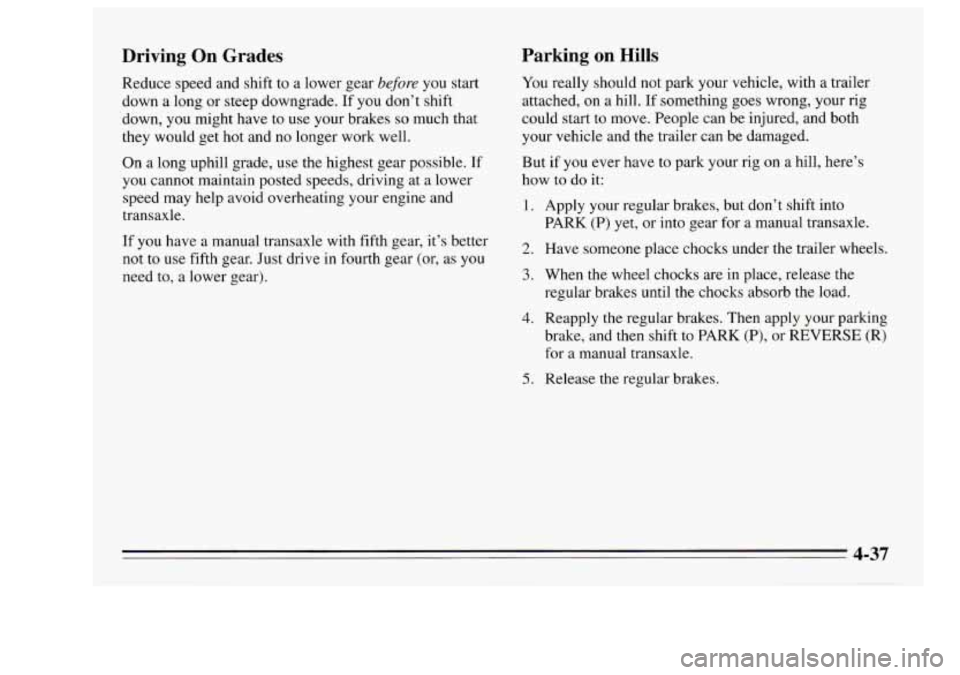
Driving On Grades
Reduce speed and shift to a lower gear before you start
down a long
or steep downgrade. If you don’t shift
down, you might have to use your brakes
so much that
they would get
hot and no longer work well.
On a long uphill grade, use the highest gear possible.
If
you cannot maintain posted speeds, driving at a lower
speed may help avoid overheating your engine and
transaxle.
If you have a manual transaxle with fifth gear,
it’s better
not to use fifth gear. Just drive in fourth gear (or, as
you
need to, a lower gear).
Parking on Hills
You really should not park your vehicle, with a trailer
attached,
on a hill. If something goes wrong, your rig
could start to move. People can be injured, and both
your vehicle and the trailer can be damaged.
But if
you ever have to park your rig on a hill, here’s
how
to do it:
1.
2.
3.
4.
5.
Apply your regular brakes, but don’t shift into
PARK
(P) yet, or into gear for a manual transaxle.
Have someone place chocks under the trailer wheels.
When the wheel chocks are
in place, release the
regular brakes until
the chocks absorb the load.
Reapply the regular brakes. Then apply your parking
brake, and then shift to PARK
(P), or REVERSE (R)
for a manual transaxle.
Release the regular brakes.
4-37
Page 182 of 340
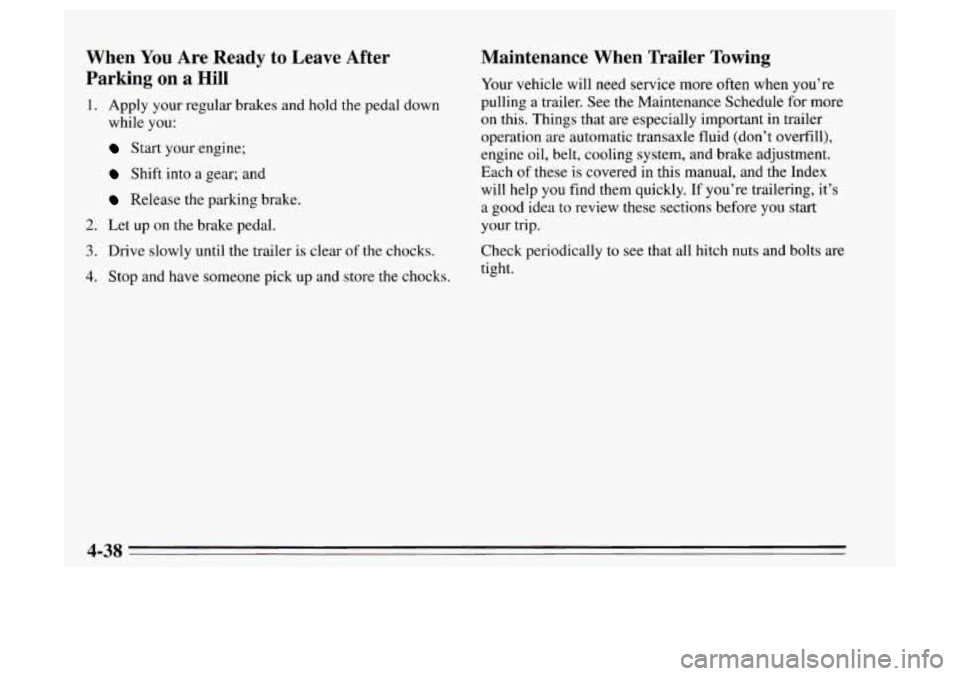
When You Are Ready to Leave After
Parking on a
Hill
1. Apply your regular brakes and hold the pedal down
while
you:
Start your engine;
Shift into a gear; and
Release the parking brake.
2. Let up on the brake pedal.
3. Drive slowly until the trailer is clear of the chocks.
4. Stop and have someone pick up and store the chocks.
Maintenance When Trailer Towing
Your vehicle will need service more often when you’re
pulling a trailer. See the Maintenance Schedule for more
on this. Things that are especially important in trailer
operation are automatic transaxle fluid (don’t overfill),
engine
oil, belt, cooling system, and brake adjustment.
Each
of these is covered in this manual, and the Index
will help
you find them quickly. If you’re trailering, it’s
a
good idea to review these sections before you start
your trip.
Check periodically to see that all hitch nuts and bolts are
tight.
4-38
-
Page 183 of 340
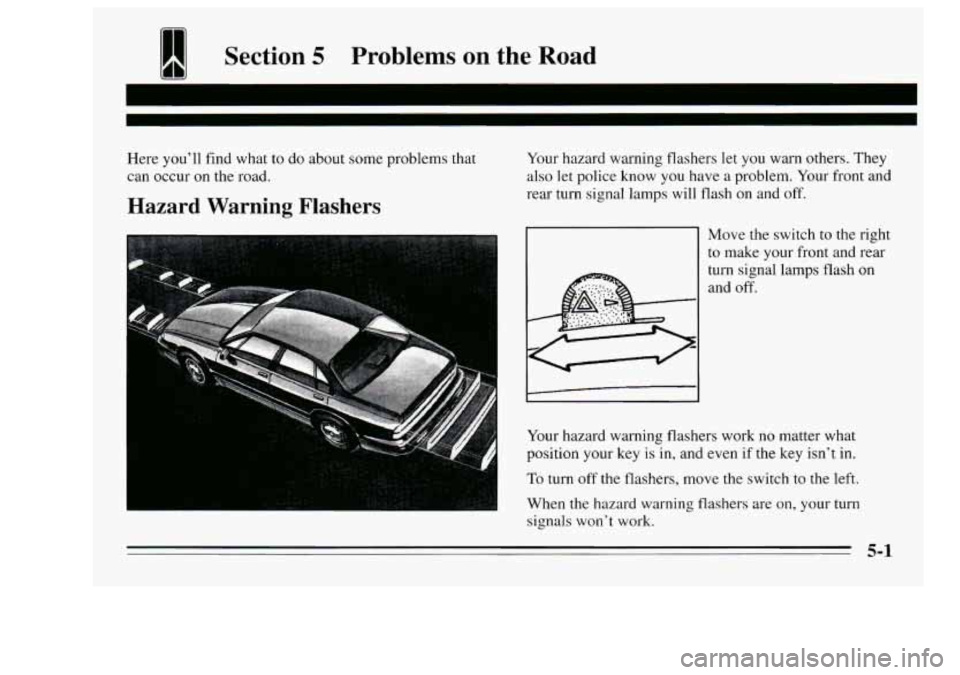
1 Section 5 Problems on the Road
Here you’ll find what to do about some problems that
can occur on the road.
Hazard Warning Flashers
Your hazard warning flashers let you warn others. They
also let police know you have a problem. Your front and
rear
turn signal lamps will flash on and off.
Move the switch to the right
to make your front and rear
II
turn signal lamps flash on
and off.
Your hazard warning flashers work no matter what
position your key
is in, and even if the key isn’t in.
To turn off the flashers. move the switch to the left.
When the hazard warning flashers are on, your
turn
signals won’t work.
5-1
Page 184 of 340
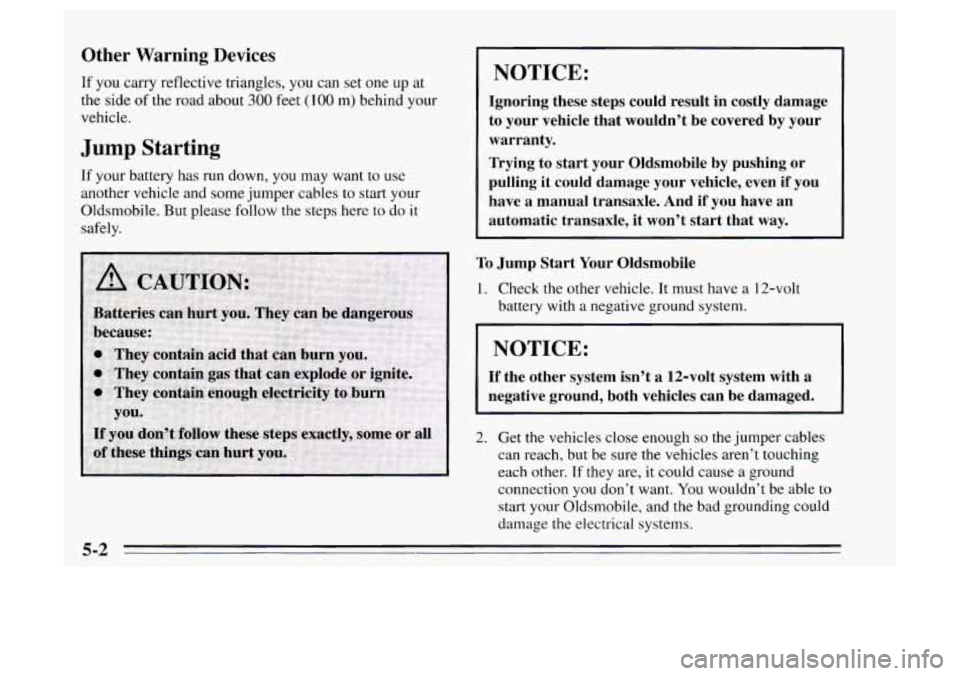
Other Warning Devices
If you carry reflective triangles, you can set one up at
the side
of the road about 300 feet (100 m) behind your
vehicle.
Jump Starting
If your battery has run down, you may want to use
another vehicle and some jumper cables to start your
Oldsmobile. But please follow the steps here to do it
safely.
NOTICE:
Ignoring these steps could result in costly damage
to your vehicle that wouldn’t be covered
by your
warranty.
Trying
to start your Oldsmobile by pushing or
pulling it could damage your vehicle, even if you
have
a manual transaxle. And if you have an
automatic transaxle, it won’t start that way.
To Jump Start Your Oldsmobile
1. Check the other vehicle. It must have a 12-volt
battery with a negative ground system.
NOTICE:
If the other system isn’t a 12-volt system with a
negative ground, both vehicles can be damaged.
2. Get the vehicles close enough so the jumper cables
can reach, but be sure the vehicles aren’t touching
each other.
If they are, it could cause a ground
connection you don’t want.
You wouldn’t be able to
start your Oldsmobile, and the bad grounding could
damage the electrical systems.
5-2
Page 185 of 340
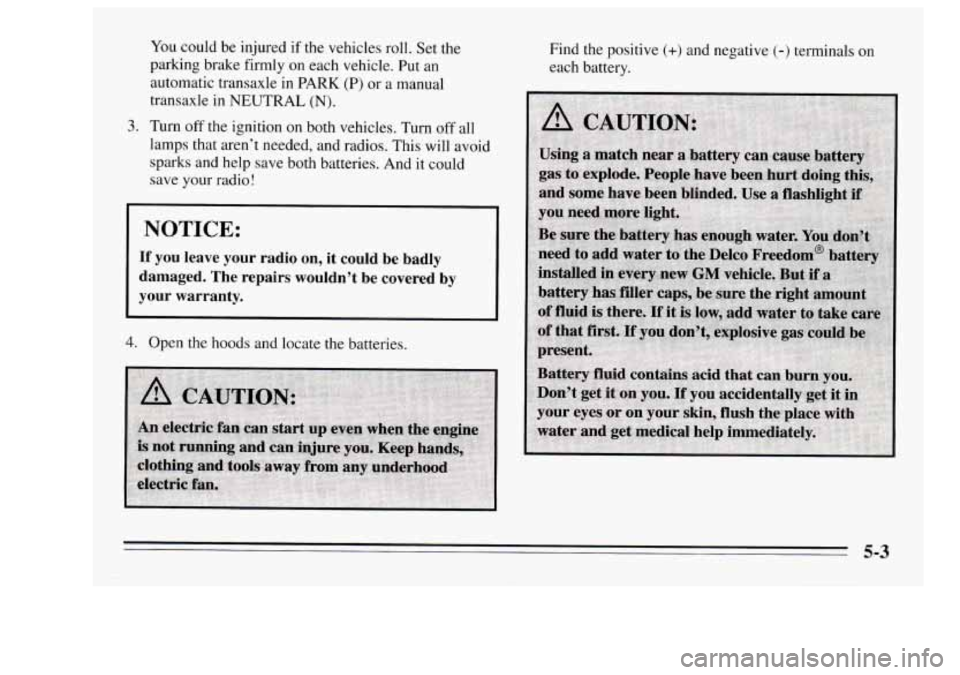
You could be injured if the vehicles roll. Set the
parking brake firmly on each vehicle. Put an
automatic transaxle in PARK
(P) or a manual
transaxle in NEUTRAL (N).
3. Turn off the ignition on both vehicles. Turn off all
lamps that aren’t needed, and radios. This will avoid
sparks and help save both batteries. And it could
save your radio!
NOTICE:
If you leave your radio on, it could be badly
damaged. The repairs wouldn’t be covered by
your warranty.
4. Open the hoods and locate the batteries. Find the
positive
(+) and negative (-) terminals on
each battery.
5-3
Page 186 of 340
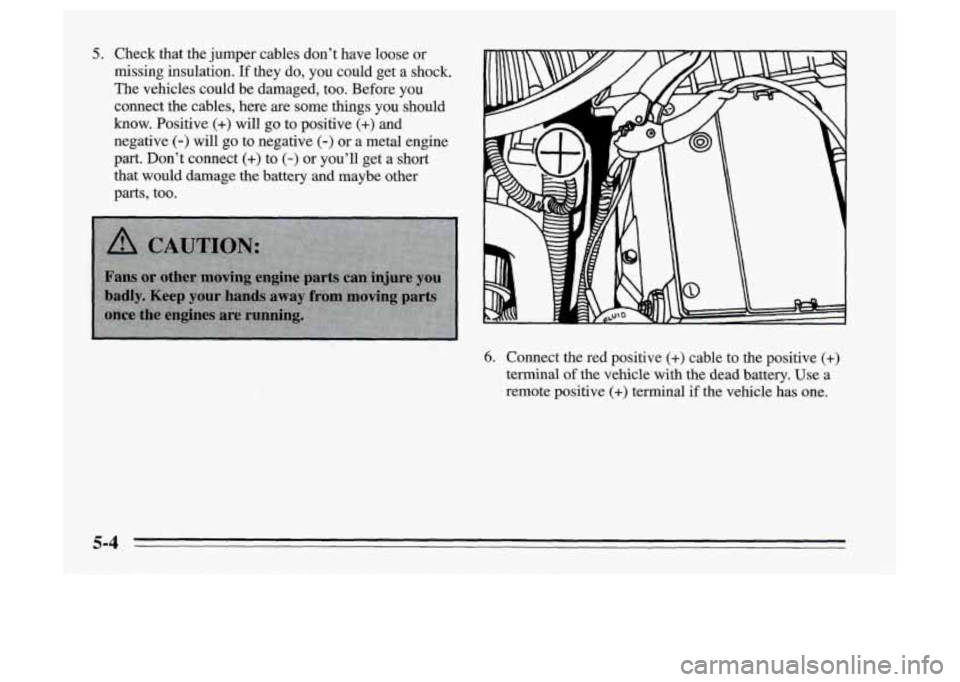
5. Check that the jumper cables don’t have loose or
missing insulation.
If they do, you could get a shock.
The vehicles could be damaged, too. Before you
connect
the cables, here are some things you should
know. Positive
(+) will go to positive (+) and
negative (-) will go to negative (-) or a metal engine
part. Don’t connect
(+) to (-) or you’ll get a short
that would damage the battery and maybe other
parts, too.
6. Connect the red positive (+) cable to the positive (+)
terminal of the vehicle with the dead battery. Use a
remote positive
(+) terminal if the vehicle has one.
5-4
Page 187 of 340
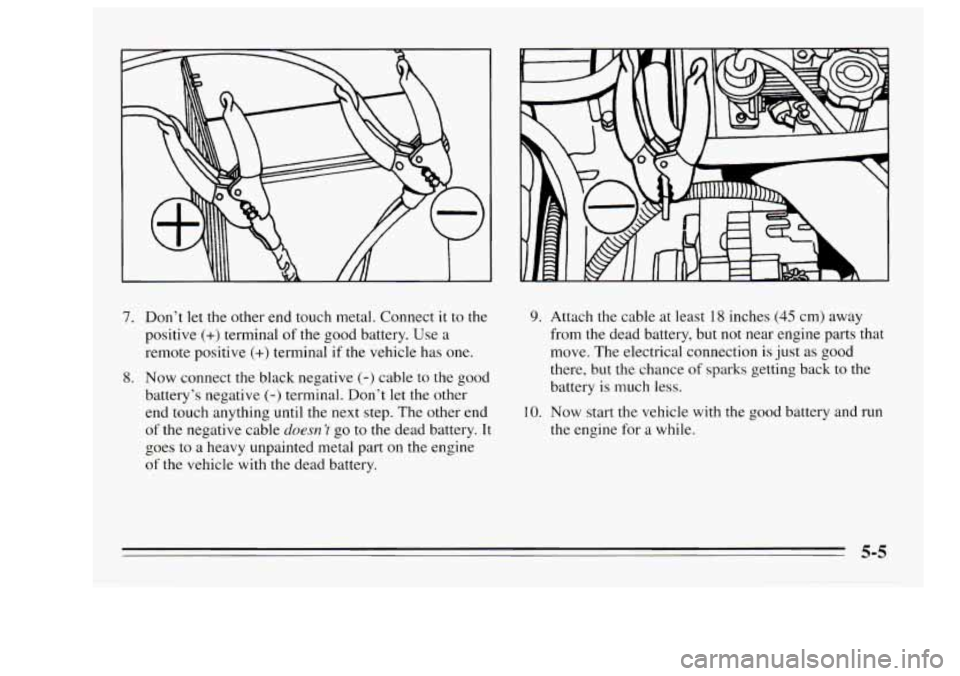
7. Don’t let the other end touch metal. Connect it to the
positive
(+) terminal of the good battery. Use a
remote positive
(+) terminal if the vehicle has one.
8. Now connect the black negative (-) cable to the good
battery’s negative
(-) terminal. Don’t let the other
end touch anything until the next step. The other end
of
the negative cable doesn’t go to the dead battery. It
goes to a heavy unpainted metal part
on the engine
of the vehicle with the dead battery.
9. Attach the cable at least 18 inches (45 cm) away
from the dead battery, but not near engine parts that
move. The electrical connection
is just as good
there, but the chance
of sparks getting back to the
battery
is much less.
10. Now start the vehicle with the good battery and run
the engine for a while.
Page 188 of 340
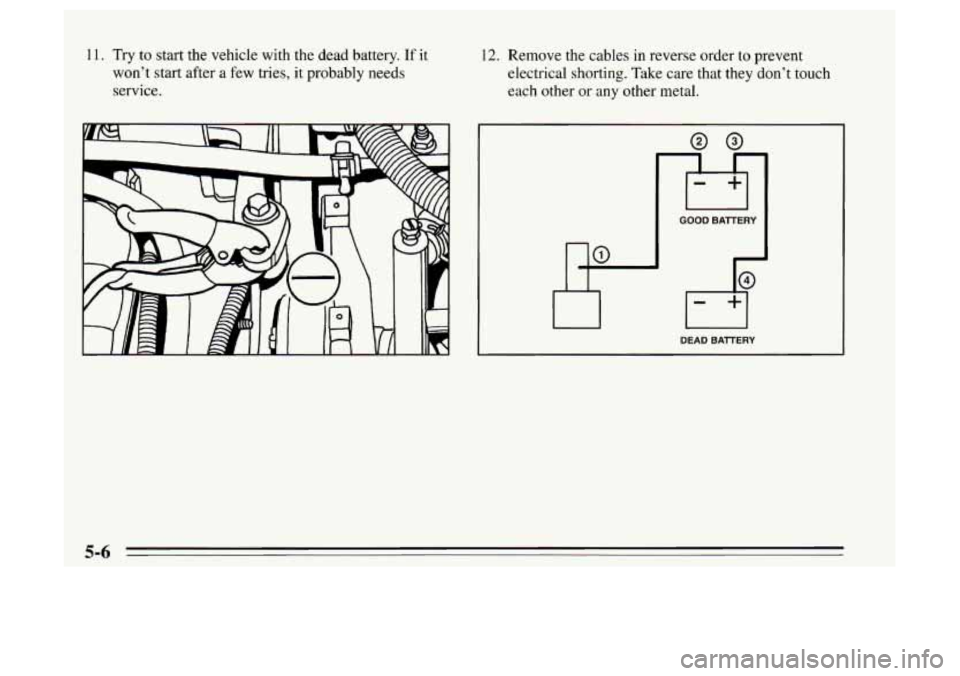
11. Try to start the vehicle with the dead battery. If it
won’t start after a few tries, it probably needs
service. 12. Remove the cables in reverse order to prevent
electrical shorting. Take care that they don’t touch
each other or any other metal.
.
l I
-+
GOOD BAlTERY
-
0
@
-+
DEAD BAlTERY
5-6
Page 189 of 340
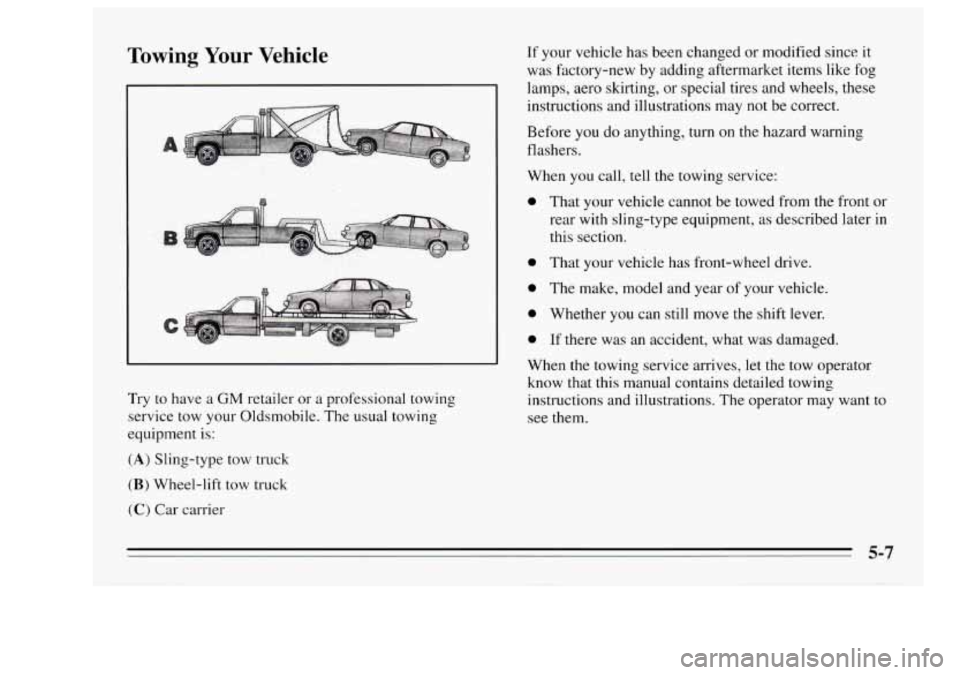
Towing Your Vehicle
Try to have a GM retailer or a professional towing
service tow your Oldsmobile. The usual towing
equipment is:
(A) Sling-type tow truck
(B) Wheel-lift tow truck
(C) Car carrier If
your vehicle has been changed or modified since it
was factory-new by adding aftermarket items like fog
lamps, aero skirting, or special tires and wheels, these
instructions and illustrations may not be correct.
Before you do anything, turn
on the hazard warning
flashers.
When
you call, tell the towing service:
0
0
0
0
0
That your vehicle cannot be towed from the front or
rear with sling-type equipment, as described later in
this section.
That your vehicle has front-wheel drive.
The make, model and year
of your vehicle.
Whether you can still move the
shift lever.
If there was an accident, what was damaged.
When the towing service arrives, let the tow operator
know that this manual contains detailed towing
instructions and illustrations. The operator may want to
see them.
5-7
Page 190 of 340
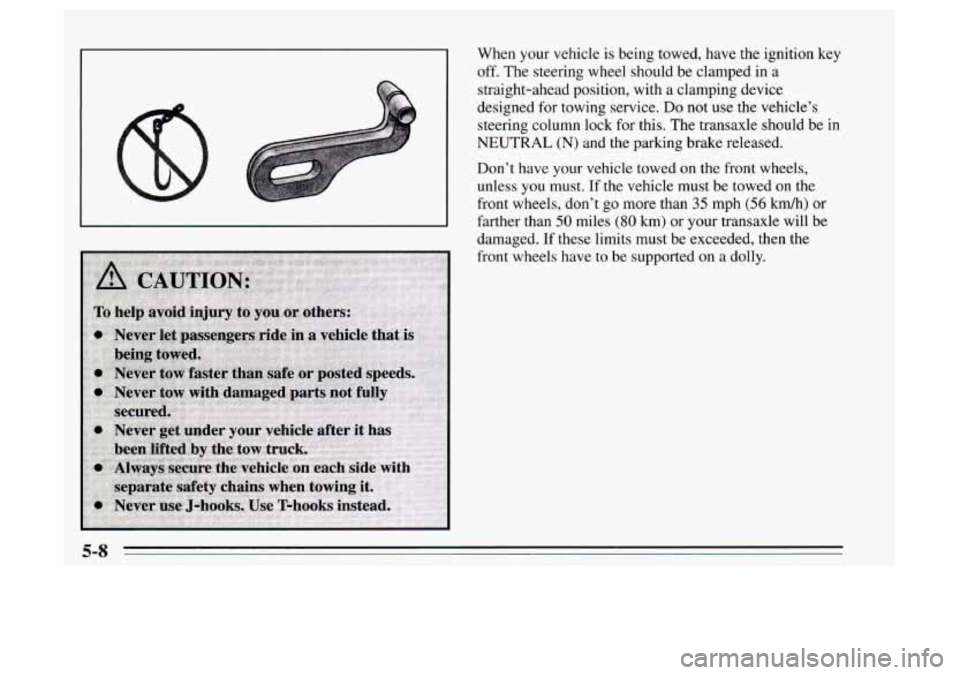
When your vehicle is being towed, have the ignition key
off. The steering wheel should be clamped in a
straight-ahead position, with a clamping device
designed for towing service. Do not use the vehicle’s
steering column lock for this. The transaxle should be in
NEUTRAL (N) and the parking brake released.
Don’t have your vehicle towed
on the front wheels,
unless you must. If the vehicle must be towed on the
front wheels, don’t go more than
35 mph (56 kmh) or
farther than
50 miles (80 km) or your transaxle will be
damaged.
If these limits must be exceeded, then the
front wheels have to be supported
on a dolly.